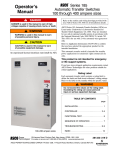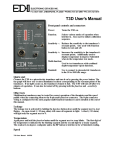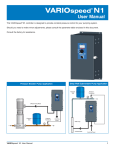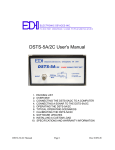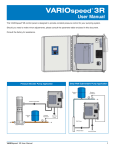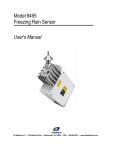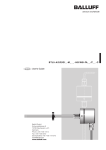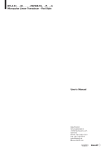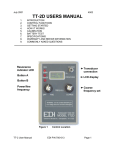Download TT-2 manual - Electronic Devices, Inc.
Transcript
June 1998 8299 TT-2 USERS MANUAL 1.0 2.0 3.0 4.0 5.0 6.0 INTRODUCTION CONTROL FUNCTIONS GETTING STARTED HOW IT WORKS SPECIFICATIONS WARRANTY AND REPAIR INFORMATION. Figure 1 TT-2 User Manual. Control Location EDI P/N 700-010 Page 1 1.0 INTRODUCTION The TT-2 is designed to test acoustic transducers for resonance over the frequency range of 500 Hz to 500 KHz. The TT-2 tests all types of transducers, including transformer-coupled and magnetostrictive devices. The load characteristic (capacitive, resistive, or inductive) is indicated by a dual color LED. Leakage current and continuity are monitored by another dual-color LED. A meter displays the relative current through the transducer over a large dynamic range. Outputs are provided for connection to the transducer under test and a frequency counter. 2.0 CONTROL FUNCTIONS Refer to figure 1 for the location of the controls discussed in this section. 2.1 METER The meter indicates the relative amount of current passed through the transducer. The higher the reading, the more current through the load. The meter will peak at series resonance, and dip at parallel resonance. There is a prominent mark on the meter scale labeled “Zo”. This Zo marker reference is used with the ZOUT knob to determine the transducer impedance at resonance. 2.2 COUNTER OUTPUT The counter output provides a 5V p-p square-wave with a source impedance of 10 K ohms, and is used when accurate frequency measurements are required. WARNING, do not connect a source of power to this connector. If you do, the TT-2 will be damaged. This is an output only. 2.3 TRANSDUCER OUTPUT The transducer output connects to the transducer under test. WARNING, do not connect a source of power to this connector. If you do, the TT-2 will be seriously damaged. This is an output only. 2.4 OUTPUT IMPEDANCE CONTROL This control governs the resistance between the TT-2's signal generator and the transducer. It is normally set in the upper ranges for high impedance transducers and lower ranges for transformer coupled units. At resonance, the impedance of the transducer is read by adjusting the ZOUT control so the meter is on the Zo mark. The impedance in ohms is the setting of the ZOUT dial times one hundred. 2.5 FREQUENCY CONTROL This control sets the operating frequency of the TT-2's oscillator. Multiply the reading by the selected range to read the frequency in KHZ. For example, if the frequency knob reads 20 and the POWER/RANGE switch is set to the X10 position, the output frequency will be 20 times 10, or 200 KHz. TT-2 User Manual. EDI P/N 700-010 Page 2 2.6 POWER/RANGE SWITCH This switch turns the power on and selects the frequency decade multiplier for the FREQUENCY CONTROL. Power off is at the maximum CCW position. The first position to the right (X10) covers 50 to 550 KHz. The next position, (X1) covers 5 to 55 KHz, and the maximum CW position (X.1) covers 500 Hz to 5.5 KHz. 2.7 RESONANCE LED This dual-color LED tells if the transducer presents a capacitive or inductive load to the TT-2. If the indicator is red, the transducer is capacitive. If green, then the transducer is inductive. At resonance this indicator is dim or extinguished. 2.8 LEAKAGE LED This dual-color LED indicates the amount of dc resistance (or leakage) through the transducer. For resistances above 3 megohms, the indicator is off. At less than 3 megohms, the indicator is red. Below 10K ohms, the indicator is both red and green, appearing orange. The red section of this led flashes briefly when the power is turned on, indicating that the battery is good. If the XDUCER output is shorted, this LED may take 70 - 80 seconds to extinguish after the short is removed. Because of the long time required for the leakage indicator to respond, always leave the TT-2 connected to the transducer for about two minutes to make sure any leakage currents will show up. 3.0 GETTING STARTED Connect the TT-2 XDUCER output to a transducer. Turn the power on and select the appropriate frequency range. Set the Z OUT knob to the mid-range position. Rotate the frequency control while watching the meter for the highest peak. The RESONANCE indicator will usually be red below resonance, and will rapidly change to green just above resonance. There will be three resonance points for most transducers. Adjust the Z OUT control so the meter falls across the Zo mark to get the most accurate and repeatable frequency reading. If it is not possible to set the meter to the Zo mark, adjust the ZOUT knob to get as close as possible to the Zo reference mark on the meter. 3.1 SORTING OUT MULTIPLE RESONANCE POINTS Most all transducers you test will have three major resonance points. A major resonance point has a significant peak in the current meter along with a quick change in the color of the RESONANCE light. The problem is to determine the correct resonant point. This will usually be the frequency where the most power is transferred from the face of the transducer. Check the energy transfer at each resonant frequency by pressing the palm of your hand on the transducer face while observing the TT-2's meter. The meter will dip noticeably with moderate hand pressure at the one of the resonant frequencies. This point is usually, BUT NOT ALWAYS, the correct operating frequency for the transducer. The TT-2's meter is usually more sensitive to transducer loading when the transducer presents a slightly capacitive load. Setting the frequency so the red RESONANCE light is barely visible will cause the largest dip of the meter when the transducer face is pressed. Often, a light touch of a finger tip at the exact TT-2 User Manual. EDI P/N 700-010 Page 3 center of the transducer face will cause a dip of the meter at one frequency only. Again, this is usually, but not always, the correct operating frequency for the transducer. 3.2 MEASURING TRANSDUCER IMPEDANCE An approximate indication of the magnitude of the transducer impedance at resonance can be obtained by adjusting the Z OUT control so the meter lays over the Zo mark, located on the meter scale. Read the scale surrounding the Z OUT control and multiply it by one hundred to get the transducer impedance. Some transducers may prevent the meter from reaching the Zo mark. In this case, remove the transducer and place a potentiometer across the XDUCER output of the TT-2. Adjust this external potentiometer till the meter reads the same value it had with the transducer connected to the TT-2. Remove the potentiometer and read the resistance with an ohmmeter. It will be close to that of the transducer impedance at resonance. Note that the transducer must be at resonance for the above tests to have any meaning. Resonance is indicated when the LOAD indicator is dim or out, and the current is at a peak. 3.3 TRANSDUCER DC RESISTANCE The approximate DC resistance of the transducer under test is indicated by the XDUCER indicator. If the resistance is less than 3 megohms, the XDUCER indicator will stay red, indicating leakage in the transducer. If the resistance is less than 10 Kilo ohms, the XDUCER indicator will show will light both the red and green LEDS. This condition indicates either a short or a transformer coupled transducer. Transformer coupled transducers usually have only a few ohms of resistance. If the TT-2 is connected to a short circuit or transformer coupled transducer, the 3 megohm (red) XDUCER light will require about 75 seconds before it goes out after removal of the short. It is best to turn the TT-2 on and wait for the XDUCER light to go out before connecting it to a transducer. Piezoelectric transducers that are not transformer coupled should not show any indication of leakage after 2 minutes. 4.0 HOW IT WORKS The TT-2 sends a signal through a variable resistor (Z OUT control) that is connected to the transducer under test. The voltage waveform at the transducer is sampled at three specific points per cycle. The relationship of the voltages at the sample points determine the phase angle and load current through the transducer. The current to the transducer is logarithmically displayed on the meter for increased dynamic range. The RESONANCE LED indicates if the load the transducer exhibits is capacitive or inductive. If the transducer is capacitive, the RESONANCE indicator will be red, and if the transducer appears to be inductive, the RESONANCE indicator will be green. At zero phase angle, the RESONANCE indicator will be very dim or off as the transducer is neither capacitive or inductive, and is purely resistive. TT-2 User Manual. EDI P/N 700-010 Page 4 5.0 SPECIFICATIONS FREQUENCY RANGE: DIAL ACCURACY: IMPEDANCE RANGE: TRANSDUCER TYPES: BATTERY TYPE: CURRENT DRAIN: EST BATTERY LIFE: RECOMMENDED BATTERY: WEIGHT: SHIPPING WEIGHT: .5 to 500 KHz, typically .1 to 550 KHZ. 10% of indicated reading, 2% repeatability. 35 - 1000 ohm, usable 10 - 10,000 ohms. All types, including transformer coupled. Standard 9V transistor radio type. 20 mA avg, 60 mA max. 4 to 6 hours intermittent use. Alkaline type similar to EVERREADY #522 or equivalent. 11 ounces with battery. 2 pounds. WARRANTY INFORMATION Unit will be repaired free of charge for one year from date of purchase providing there is no water damage or other evidence of improper use or handling. Purchaser must ship unit prepaid to address below; EDI will pay the return freight. Please call before shipping your unit back to us. 6.0 For repair ship to: Electronic Devices, Inc. 3140 Bunch Walnuts Road Chesapeake, VA. 23322 ATTN: Service Department Please enclose a note describing the problem. 6.1 BATTERY REPLACEMENT The battery compartment is located on the bottom of the TT-2, under the meter area. Remove the battery cover by pressing down and outward with your thumb. The cover will then slide free from the case, exposing the battery. The battery should be replaced if the voltage falls below 6 volts while under load. To check this, set the Z OUT control to the 1 position. Short the XDUCER output by clipping the test leads together. Turn the TT-2 on and measure the voltage at the battery terminals. If possible, use 9V alkaline type batteries for replacement. TT-2 User Manual. EDI P/N 700-010 Page 5





